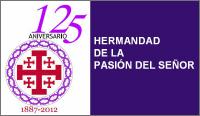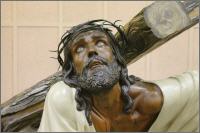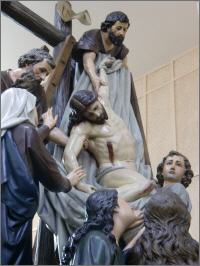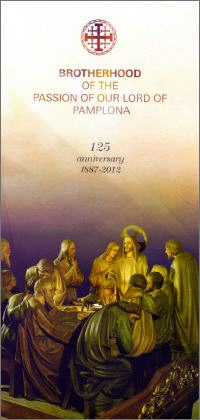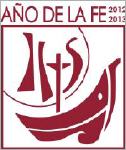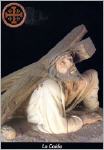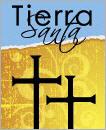BROTHERHOOD OF THE PASSION OF OUR LORD OF PAMPLONA
125 anniversary 1887-2012
Brotherhoods within the Catholic Church
In addition to being members of a Parish, the catholics form, with voluntary character, associations of faithfuls, who have one or several objectives:
a) Spiritual solidarity: they develop the spiritual life and the oration, they offer suffrages by the souls of the brothers.
b) Material solidarity: to take care of the patients, widows, poor men and destitutes, own as much other people's.
c) Public worship: to make public ceremonies and processions by the streets, in which God, the saints or a mystery of the faith, such as Eucharist are worshipped.
d) Penance: when the worship talks about the Passion of Christ, by means of processions that represent images (calls Penance steps). Simultaneously, the brothers make penance by their sins and they are united to the sacrifice of Christ in the Cross.
Penitenciales brotherhoods and of public cult
They had great development in Spain since the Catholic Reformation of 16th century. The Council of Trento impelled the cult to the images, as an average one to represent of visible form the contents of the faith.
In 17th century, the culture of the Baroque impelled the public cult, the beauty and the wealth of the liturgical forms, the theater representation of the mysteries of the faith. Against this background, the processions with images took great height in Spain (Penance steps), specially the referred ones to the Passion of Christ, that were celebrated in Easter.
These processions also had a noticeable penitential character. The participants made exercise of penance, to repair the damages derived from their sins and to identify themselves with Christ and to be united to him in their Passion.
The Precedents of the Brotherhood
There were several brotherhoods related to the Passion in Pamplona The Brotherhood of the Solitude, which was municipal and was founded on 1602, organized the Holy Funeral Procession in Good Friday; on her their respective steps participated to diverse brotherhoods taking.
Among them three can be emphasized. They were the predecessors of the present Brotherhood of the Passion:
a) Brotherhood of the Holy Sepulcher. It existed before 1649. It was mainly formed by craftsmen.
b) Brotherhood of the Raised Christ (Christ in the Cross), formed in 1784.
c) Brotherhood of the Oration in the Garden, very old and recovered in 1832.
Foundation of the Brotherhood of the Passion (1887)
The wars and Spanish confiscations of 19th century caused the decay of the Brotherhoods of Passion in Pamplona. The cholera epidemic of 1855 produced many deaths of members of the Brotherhood and great expenses. In 1873 the republican City Council suppressed to the processions and the municipal brotherhoods. In 1878 they recovered the first ones, but not the second ones. The survival of the public worship of Easter was in danger.
In order to avoid it, the catholics decided to organize themselves without depending on the municipal authorities. The principle "united we stand" prevailed. The Brotherhoods of the Holy Sepulcher, the Raised Christ and the Oration in the Garden decided to be united in a single one, that organized the procession of Good Friday.
Therefore the Brotherhood of the Passion of the Our Lord was born the 18 of January of 1887.
Renovation of the procession (1887-1952):
The tradition of which the brothers go untuniced in the procession of Good Friday does not have anything to do with a secret nor esoteric society. It symbolizes two principles of Christian spirituality rather.
The untuniced ones recognize themselves as penitents and sinners and for that reason they cover their faces as a sign of shame because of their sins and regret. In addition the tunic means the radical equality of all the Christians and all member inside the Brotherhood, independently of its social, economic or political condition.
The union produced growth of brothers and resources and brought splendor to the worship of Easter. The passages of the procession renewed: Holy Sepulcher (1887), the Descent (1906) and soon all the others, until the eleven present ones.
In addition an allegorical-Biblical sense occurred to the procession, with the incorporation of figures of the Old Testament. It was tried with it to represent all the History of the Salvation, finishing with the New Alliance sealed by Christ in the Cross.
Nowadays the procession of Pamplona is composed by 11 Penance steps, that relate the main moments of the Passion of Christ:
1. Entrance of Jesus in Jerusalem.
2. Last Supper.
3. Oration in the garden.
4. The Capture
5. The Scourging
6. "Ecce Homo".
7. Our Lord Jesus with the Cross to hills.
8. Fall of Our Lord
9. Raised Christ.
10. Descent from the Cross.
11. Holy Sepulcher
It closes the procession the image of the Painful Virgin, property of the City council of Pamplona.
Development and transformations of the Brotherhood
Traditionally the Brotherhoods of Passion were single masculine and the women could not belong to them.
In order to incorporate to the woman to the tasks of the Brotherhood of the Passion, the Section of Sisters of the Solitude in 1926 was created.
In 1955 the new seat of the Brotherhood was constructed. As time goes by the rules of government were adapted. New Statutes in 1947 and 1987 were promulgated. These last ones supposed the incorporation of the renovation promoted by Vatican Council II: extension of the worship to the Resurrection, emphasis in the exemplary nature of life and the charity of the brothers, equality of men and women, etc.
BROTHERHOOD OF THE PASSION OF OUR LORD OF PAMPLONA
125 anniversary 1887-2012
English version
download information
